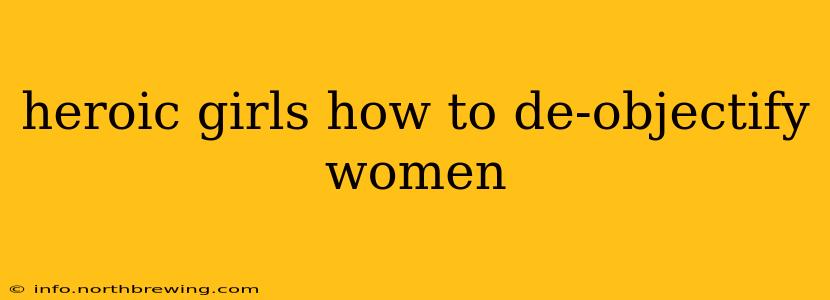The image of the "damsel in distress" is a tired trope. Fortunately, we're seeing a rise in heroic girls—strong, capable female characters who defy stereotypes and challenge the objectification of women in media and beyond. But how do we move beyond simply showcasing strong female characters to actively de-objectifying women? It's a multifaceted challenge requiring a conscious effort across various platforms and perspectives. This article delves into the crucial steps needed to achieve a more equitable and respectful portrayal of women.
What Does it Mean to De-Objectify Women?
Before we explore solutions, let's define the problem. Objectification reduces a person to their physical attributes, ignoring their personality, intelligence, and complexities. In media, this often translates to:
- Hypersexualization: Focusing on a woman's body rather than her character.
- Fetishization: Presenting women as fulfilling specific male fantasies, rather than as individuals with their own agency.
- Stereotypical Roles: Confining women to limited and often submissive roles (e.g., the helpless damsel, the seductive temptress).
- Lack of Agency: Depicting women as passive recipients of action, lacking control over their own narratives.
De-objectifying women means moving away from these harmful representations and portraying them as fully realized individuals with depth, agency, and diverse experiences.
How Can We Create More Heroic Girls and De-Objectify Women?
1. Focus on Character, Not Just Appearance:
This is fundamental. Develop female characters with rich backstories, compelling motivations, and internal conflicts. Their physical appearance should be secondary to their personality, skills, and ambitions. Give them flaws, vulnerabilities, and strengths—making them relatable and human.
2. Give Female Characters Agency and Control:
Empower female characters by allowing them to make their own choices, shape their destinies, and drive the narrative. They shouldn't be merely reacting to events; they should be active participants, making decisions that impact the story's trajectory.
3. Avoid Hypersexualization and Fetishization:
Resist the urge to sexualize female characters unnecessarily. Focus on their actions, their intelligence, and their relationships, not their bodies. Avoid gratuitous nudity or suggestive poses that serve no purpose other than to titillate the audience.
4. Challenge Gender Stereotypes:
Move beyond the typical tropes. Create female characters who are scientists, warriors, leaders, entrepreneurs, mothers, and anything else that defies the traditional limitations placed upon women.
5. Diversify Representation:
Ensure that female characters reflect the diversity of the real world. Include women of different races, ethnicities, body types, sexual orientations, and socioeconomic backgrounds.
6. Behind the Scenes Matters Too:
De-objectification extends beyond the characters themselves. Having women in positions of power—writers, directors, producers—ensures that diverse voices are heard and that female characters are portrayed authentically and respectfully.
7. Promote Positive Role Models:
Showcase strong, positive female role models who challenge the status quo and inspire audiences. These characters can encourage young girls to believe in their own potential and to strive for their goals.
8. Engage in Critical Discussion and Self-Reflection:
Continuously evaluate the portrayal of women in media and engage in thoughtful discussions about how we can do better. This includes self-reflection on our own biases and assumptions.
Frequently Asked Questions (FAQ)
How can I tell if a female character is being objectified?
Consider if the character is defined primarily by her physical attributes, if her storyline revolves around male attention or desire, or if her agency and voice are diminished. Ask yourself: Is this character a person, or a collection of desirable traits?
Isn't it okay to have strong female characters who are also attractive?
Absolutely! Attractiveness shouldn't negate a character's strength, intelligence, or depth. The key is balance—a character's physical appearance shouldn't overshadow their other qualities.
What role does the audience play in de-objectifying women in media?
Audiences have power. By actively choosing to support media that portrays women respectfully and critically engaging with media that falls short, we can send a message to creators and influence future productions. Vocalizing our dissatisfaction or appreciation is crucial.
By implementing these strategies and fostering a culture of respect and inclusion, we can create heroic girls who inspire, empower, and redefine the way women are portrayed in media and society at large. The journey towards true representation is ongoing, but with conscious effort and collective action, we can move towards a more equitable and empowering future.
